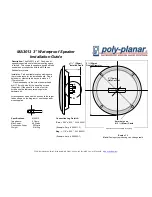
VRC4500/5000 VERTICAL WINDLASS
INSTALLATION
4
LOCATING THE WINDLASS
When installing the windlass it is important to consider the
following requirements for efficient operation of the whole
anchoring system.
A clear and horizontal Chain Path
Correct Positioning and Locker Depth
Maximizing the Wrap of Chain around the Gypsy
Position of the Motor and Gearbox Under deck
Insulation of Dissimilar Metals
The windlass should be positioned centrally over the chain
locker. This helps to maximize the fall of chain down to the
locker as it piles up when retrieving the anchor (See the fall
depth table).
It is a common mistake to locate the windlass too far
forward, or too close to the bulk head, where there is
insufficient room for the chain and anchor stowing. In
installations where this is not possible a length of 'lead in'
tube with a belled end and a bore of at least 2 times the
chain width can be used to guide the chain to the centre of
the chain locker. This extension needs to be a minimum of
45
0
to 90
0
from the under deck. Angles less than 45
0
will
increase chain drag within the tube.
The gear drive can be fitted in multiple positions to allow the
chain to fall away from the motor. If the motor is positioned
near the falling chain then the lead in tube is also
recommended to protect the motor from water.
Chain Size
Minimum Fall Depth To
Top Of Heaped Chain
Up to 1/2” (13mm)
36” (914mm)
5/8” to 7/8”(16 to 22mm)
48” (1220mm)
1” (25mm) and Above
48” (1220mm) or Greater
When fitting the base plate all mating surfaces should be
coated with sealant, to ensure enough is applied allow it to
squeeze out as the mounting bolts are tightened.
After fitting the base plate in the desired position the
windlass can be reassembled using the assembly
instructions on the following page.
The chain pipe should be fitted last making sure to match the
height of the chain from the gypsy. Ideally this should line up
with the chain after it has wrapped 180 degrees around the
gypsy; this angle of wrap should not be less than 140
degrees for the correct operation. Refer to diagram in
appendix for correct chain pipe and peeler setup
If the windlass is to be mounted on a steel or alloy deck an
insulator, preferably some form of rigid plastic must be used
to avoid contact of dissimilar metals. It is also advisable to
insulate the mounting bolts with plastic sleeves.
If the vessel has a curved deck an appropriately shaped
mounting block must be used.
Reassemble the windlass, fitting the shaft and top assembly
complete, (refer exploded view) using a waterproof grease to
lubricate all parts and running gear.
It is important to thoroughly lubricate all mating surfaces with
grease suitable for marine applications before use. As the
windlass will be operating in an extremely corrosive
environment it is also highly recommended that corrosion
protection be used on the external surfaces of the motor,
gear drive and adaptor, and also in any areas where water
may lie to protect against moisture in the chain locker (See
the maintenance section for additional information).
ELECTRICAL INSTALLATION
Ensure all wiring is completed as per supplied wiring
diagram and that all circuit components and wire is suitable
for the system rating. To maintain the manufacturer’s
warranty on the windlass a suitably rated overload protection
must be installed to protect the motor.
HYDRAULIC INSTALLATION
To ensure minimal pressure loss or heat build up, it is
recommended that hydraulic piping of the following minimum
size is used.
Length of Line
Pipe Size (Outside Diameter)
Up to 30’ (9.1m)
5/8” (16mm)
Over 30’ (9.1m)
3/4” (19mm)
To maintain the manufacturer’s warranty on the windlass a
pressure relief valve must be installed to the hydraulic circuit.
Muir also recommends that a counterbalance valve be
installed to the hydraulic motor to prevent runback.
4500
Summary of Contents for VRC4500
Page 9: ......



























